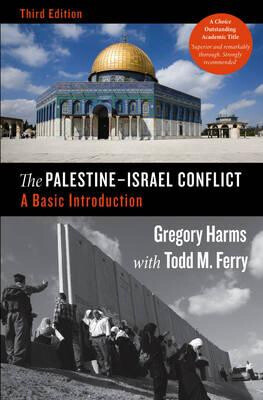The Electronic Intifada London 13 September 2012

The Palestine-Israel Conflict: A Basic Introduction is a bold attempt to convey “over a million years of history in 204 pages” (xx). Gregory Harms is an independent scholar based in Chicago, who has attempted here to distill a whole bookcase of academic texts down into this small volume intended as a basic guide for those new to the topic.
Anyone who has dedicated much of his or her work or activism to Palestine will often be asked by friends or family for recommendations on just such a book to read. Something easy to digest, that covers a wide area of topics, while suggesting further reading.
Harms sketches out the history of Palestine from ancient times, through the Ottoman period, the origins of Zionism, the Israeli occupation and down to the present day. He covers a wide range of material in a short space.
Harms must have found an audience, as this is the third edition of the book, newly issued by Pluto Press. Unfortunately, while not without its merits, the book is ultimately flawed.
Dispelling myths
One novel aspect here is the first chapter, written by archaeologist Todd M. Ferry, in which he goes back to the dawn of history in ancient Palestine. He gives an overview of its many different kingdoms, peoples and religious. For overview histories of this nature, this is an unusual, and welcome, approach. It dispels Biblical mythology simply by presenting the basic facts of archeology.
Harms says the reason for this approach was to address “the Thousand Year Myth. Naturally, the best way to dispel any myth is to present the facts… ‘those people’ have not been fighting ‘for thousands of years’ ” (xiv). This point is well made.
The first two parts of the book, covering the background history, and what he terms the “pre-conflict” (the dawn of Zionism until the Second World War) are fairly solid.
Fundamental flaws
But the book does not live up to this early promise. The central flaw is its woefully inadequate treatment of the Nakba, Israel’s ethnic cleansing of 750,000 Palestinians in 1948.
Harms describes a “civil war” and a “provocation-reprisal pattern” in which “the Zionists fought defensively” and even describes Zionist terrorist militia the Haganah as a “Jewish defense force” (93). While he does mention the “terror and fight” caused by the Zionist massacre in the Palestinian village of Deir Yassin, he does not adequately cover the far wider pattern of ethnic cleansing of which Deir Yassin was only one massacre of many, albeit the most infamous.
He inaccurately claims the Palestinian term Nakba (catastrophe) is a reference to the loss of “the independence the Palestinians so desired” (99), when the more salient point is the expulsion of the Palestinians, rendering them refugees. Nakba Day is commemorated every year to call for the refugees’ right of return to Palestine, not simply for “independence.”
Harms says that “attacks like Deir Yassin were occurring and exodus was then as much due to fear as as forced expulsion” (101) but never uses the now widely accepted term “ethnic cleansing.” Harms ignores the important work of Ilan Pappe (and his seminal text The Ethnic Cleansing of Palestine) but draws heavily on the work of Benny Morris throughout, and especially in this section.
That is Harms’ choice, of course, but it was remiss of him not to mention that even Morris considers ethnic cleansing the correct framework to understand what Zionism did to the Palestinians in 1948. The difference between Morris and Pappe, of course, is that the former thinks the ethnic cleansing was justified while the latter thinks it was immoral (“Survival of the fittest,” Haaretz, 8 January 2004).
The Nakba and its consequences remains the ongoing central issue of the “conflict” so I consider this a deal-breaker.
The problem of “balance”
There are other problematic sections, such as his treatment of the second intifada, neglecting to convey how it started as a popular uprising and later morphed into a militarized insurgency (169). And there are many smaller giveaways, such as his use of euphemistic Israeli or Western terminology - e.g. describing the tripartite aggression by Israel, Britain and France against Egypt in 1956 as the “Suez Canal Crisis” (106) or the occupation of the West Bank and the Gaza Strip in one place as an “acquisition” (111).
At the root of such problems is Harms’ fundamental approach, which he spells out in the preface: “I have sought to present the history of the conflict in a balanced and actual light” (xv). The aim of imposing the prism of “balance” on the fundamentally imbalanced situation of a settler movement’s ongoing colonization of an occupied land is doomed to failure. This lies at the heart of much of what is wrong with the book.
Taken together, these problems mean that when asked by for a good introduction to Palestine-Israel I still recommend the great little book by my friend (and fellow Electronic Intifada contributor) Ben White: Israeli Apartheid: A Beginner’s Guide. While the broader historical sweep of Harms’ book means the two are not directly comparable in some ways, I’d still pick White’s book since it has a far stronger treatment of issues that go to the very heart of the matter.
Asa Winstanley is a journalist from London who has lived and worked in occupied Palestine. His website is: www.winstanleys.org.






Comments
Hidden Histories - Palestine and the Eastern Mediterranean
Permalink Andrea Summers replied on
For an in-depth, detailed look into the ancient history of Palestine, see Basem L. Ra'ad's comprehensive study "Hidden Histories - Palestine and the Eastern Mediterranean", Pluto Press, 2010